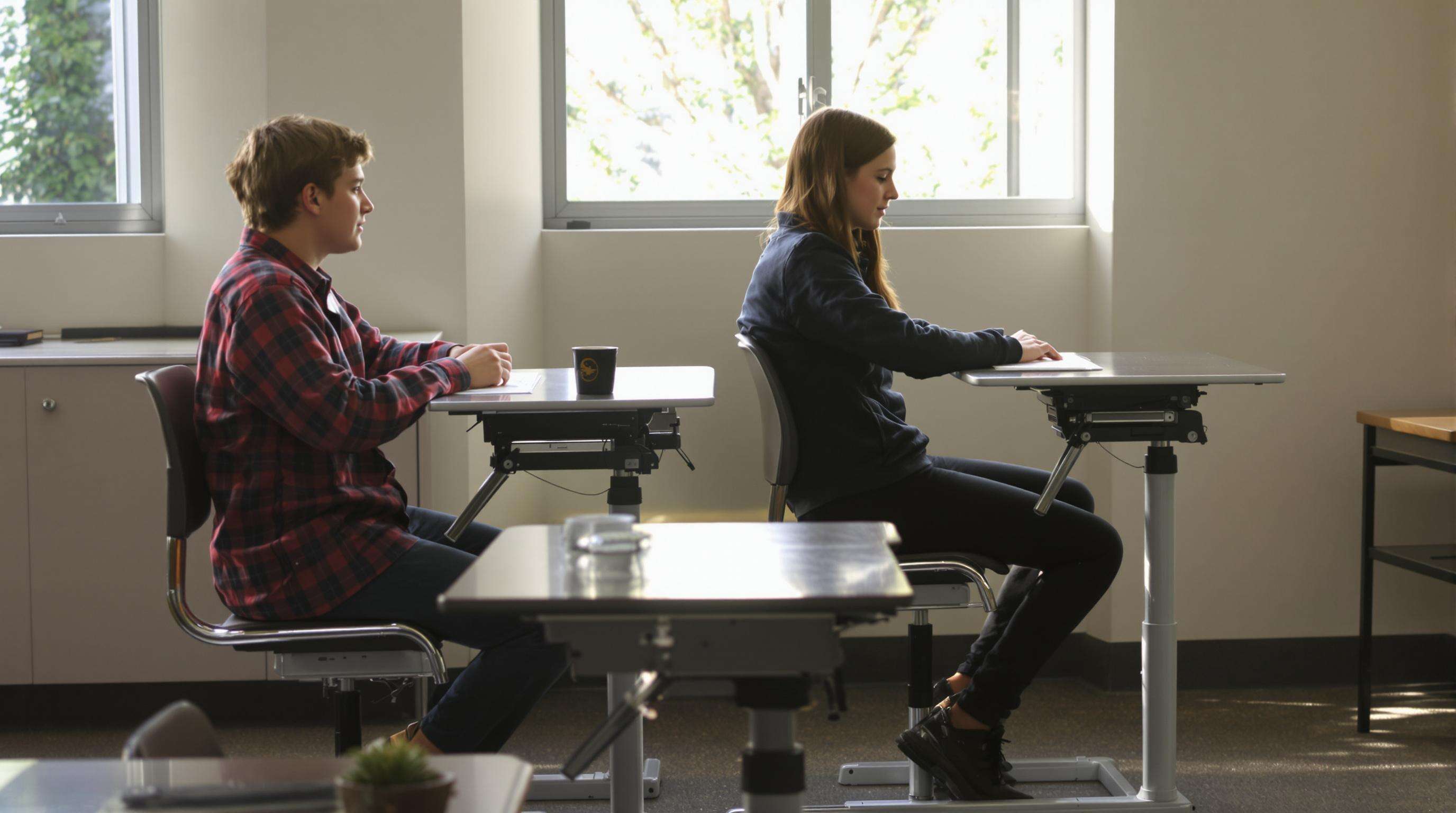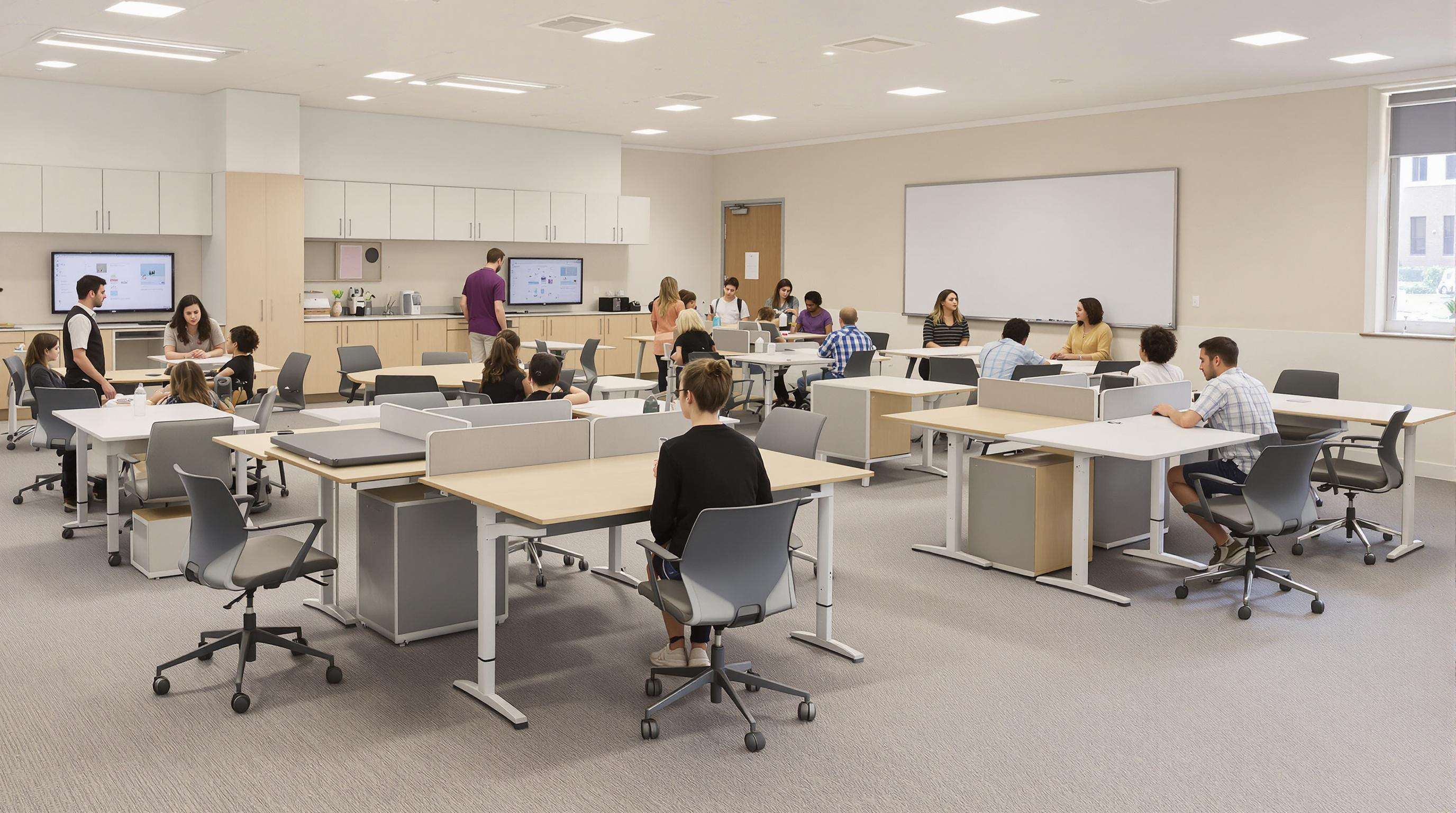Adjustable Classroom Table and Chairs for Adolescent Growth

Adjustable-Height Desks and Their Impact on Physical Development
Classroom tables and chairs these days are designed with flexibility in mind, especially since kids go through those awkward growth spurts. When students can adjust their desk heights, they tend to sit in better positions overall. Think about it: elbows bent around 90 degrees, feet planted firmly on the ground instead of dangling. This simple setup makes a big difference for young bodies, cutting down on all that neck and back pain so many teens complain about. Some research from the UK in 2023 backs this up too. The study showed that kids who had access to adjustable desks experienced about 32 percent fewer problems with muscles and joints compared to classmates stuck with regular old fixed desks. Makes sense really when you think about how much time students spend sitting during the school day.
Matching Classroom Table and Chairs to Changing Body Proportions in Adolescence
The height differences among teenagers in the same age bracket can be as much as 30 centimeters, which means standard seating just won't cut it anymore. Adjustable chairs that offer seat depths between 40 and 50 cm work well, paired with desks that can go from around 60 cm up to 80 cm high. Take two 14 year olds for instance one might stand at 175 cm while another is only 150 cm tall. That creates quite a gap when it comes to desk height requirements, with the taller student needing something nearly 18 cm higher than their shorter classmate. Schools are starting to realize this reality as they try to create learning environments where everyone actually fits comfortably.
Data on Height Variation and Furniture Design Implications
| Age Group | Height Range (cm) | Recommended Desk Height (cm) |
|---|---|---|
| 11-12 | 142-162 | 64-72 |
| 13-14 | 152-178 | 68-76 |
| 15-16 | 160-185 | 72-80 |
This variance explains why static 72 cm "standard" desks fail 60% of UK Year 9 students, according to ergonomic research by IA France. Progressive schools now implement 3–4 adjustable preset heights per classroom.
Case Study: UK Secondary Schools Implementing Adjustable Desks
Bristol’s Parkfield Academy redesigned 42 classrooms with fully adjustable systems, resulting in:
- 41% reduction in student posture-related complaints
- 18% fewer early dismissals for discomfort
- 12% improvement in writing task completion times
Teachers noted smoother transitions between seated and standing work modes, particularly benefiting students with ADHD or concentration challenges.
Ergonomic Design to Support Posture and Musculoskeletal Health
Ergonomic Design for Student Comfort and Posture During Long Class Hours
These days, classroom furniture is getting smarter about comfort. Schools are starting to invest in tables and chairs that actually consider how students sit for hours on end. According to research from the Health and Safety Executive back in 2023, classrooms equipped with those special chairs that have adjustable lower back support reported way fewer cases of kids complaining about sore backs. The difference? A massive 57% drop in discomfort claims when compared to old fashioned stiff seating arrangements. What makes these newer designs work so well? They come with seats that can be adjusted to fit different body sizes and mesh backs that let air circulate while still providing proper support for the spine throughout those long school days that stretch from morning till afternoon.
Link Between Student Posture and Musculoskeletal Health in Classrooms
Studies have shown that how classrooms are furnished actually affects the musculoskeletal health of teenagers. According to data from the CDC released last year, most teens sit for about 85 percent of their time in school, which puts quite a bit of stress on growing spines. When desks aren't properly angled or chairs can't be adjusted to fit different body sizes, students end up craning their necks forward in uncomfortable positions. This has led to an increase in problems like neck pain and issues with lower back discs among kids between 12 and 16 years old. Schools really need to pay attention to this because these problems can stick around well into adulthood if not addressed early on.
Scientific Evidence on Health Impacts of Prolonged Sitting in Teens
A 2024 meta-analysis in the European Journal of Pediatrics of 12,000 students across 45 schools found ergonomic interventions reduced early-onset scoliosis markers by 39%. The study supports dynamic seating systems that allow micro-movements, maintaining muscle engagement without disrupting learning.
Controversy Analysis: Are Standard Desks Contributing to Teenage Back Pain?
According to recent data from the Department for Education, about two thirds of secondary schools across the UK continue using those old fixed height desks. Many people have been asking if spending money on better ergonomics really makes sense financially. But wait, there's something interesting coming out of Manchester University research. Schools that upgraded their furniture actually ended up saving around 18 pounds and 50 pence per pupil each year. These savings came from fewer kids needing physiotherapy sessions and less time off school due to back problems. So maybe those initial costs aren't so bad after all when looking at long term benefits for both students and budgets.
Flexible and Collaborative Classroom Furniture Configurations

Classroom furniture these days needs to keep up with how teachers are changing their approaches, especially when it comes to getting kids involved in hands-on projects together. Many top furniture companies have started making desks that can be rearranged easily from solo work setups to small group areas where students can collaborate face to face. Makes sense really, because studies indicate that when classrooms are set up this way, students tend to get more into their science and math classes. One particular study from the University of Salford back in 2025 found that engagement levels jumped by around 28 percent in those flexible learning spaces.
Reconfigurable furniture for dynamic teaching and evolving educational needs
Height-adjustable tables with lockable casters enable teachers to quickly reconfigure spaces for lectures, debates, or lab activities within a single class period. Modular trapezoidal desks are especially effective, allowing U-shaped discussion setups or hexagonal collaboration clusters without additional furniture.
Collaborative desk configurations for group work and peer engagement
Classroom trials show clustered desk arrangements improve peer-to-peer knowledge sharing by 40% compared to traditional rows. When paired with lightweight chairs featuring 360° swivel bases, these setups allow rapid team formation while maintaining ergonomic support. A 2025 study on collaborative learning environments found schools using mobile furniture reduced classroom transition times by 15%.
Classroom layout and design for student learning: From rows to clusters
Progressive schools now use three core layouts:
- Theater-style rows for focused lectures
- Pod formations with 6–8 students for project work
- Perimeter arrangements for demonstration-based teaching
This strategic variability helps sustain adolescent focus during 75-minute lessons, with teachers reporting 31% fewer posture-related distractions than with static configurations. As educational needs evolve, furniture flexibility ensures classroom table and chairs remain aligned with both pedagogy and teenage development—a principle further reinforced through user-centered design.
User-Centered Design Through Student Feedback and Real-World Testing
Customization of School Furniture for Different Age Groups and Body Types
Modern classroom table and chairs require 32% more size variations than primary school furniture to accommodate adolescent growth (Ergonomics in Education Report 2023). Manufacturers now use anthropometric data across 12–18 year olds to create tiered systems. A 2022 UK study found students using size-matched desks reported 17% fewer posture-related complaints during lessons.
Involving Students in the Design Process: Case Study From Scandinavian Schools
Scandinavian schools have pioneered student co-creation workshops, where teenagers test prototype desks with adjustable tilt surfaces and modular storage. In a 2023 Norwegian trial, over 74% of participants preferred these user-designed models, citing improved ease of movement between individual and group tasks.
Evaluating Comfort and Usability Through Real-World Classroom Trials
A six-month evaluation across 12 secondary schools revealed key performance metrics:
| Trial Period | Comfort Score Improvement | Task Completion Speed |
|---|---|---|
| 1 month | 22% | +8% |
| 6 months | 41% | +19% |
Schools incorporating trial feedback achieved 53% higher long-term adoption rates for new furniture than those using standard procurement (Classroom Innovation Journal 2024).
Enhancing Student Focus and Engagement Through Optimized Furniture
Evidence Linking Ergonomic Furniture in Education to Improved Concentration
Students using ergonomic classroom table and chairs demonstrate 23% longer sustained focus during lessons compared to traditional setups (EdTech Journal, 2023). Key factors include:
- Reduced physical strain via adjustable lumbar support and seat depth
- 34% fewer posture corrections per class
- Stable work surfaces that minimize fidgeting
A Leeds University trial found math problem-solving accuracy improved by 18% when height-adjustable desks were paired with tilt-surface writing areas, indicating a direct link between furniture design and cognitive performance.
How Collaborative Seating Features Enhance Classroom Interaction
Modern configurations prioritize modularity, with 72% of UK secondary schools adopting reconfigurable trapezoid desks for rapid transitions between individual and group work. Teachers report:
- 42% faster peer-to-peer knowledge sharing in science labs
- 29% increase in cross-table participation during debates
- Improved sightlines for monitoring collaborative tasks
This flexibility supports project-based learning, transforming furniture into an active pedagogical tool.
Trend Analysis: Schools Reporting Higher Engagement After Furniture Upgrades
Post-implementation surveys across 47 European schools revealed:
| Metric | Improvement | Timeframe |
|---|---|---|
| Class participation | +31% | 6 months |
| Homework completion | +27% | 1 year |
| Teacher-reported focus | +39% | 2 years |
Schools that combined ergonomic upgrades with student-centered layout workshops saw engagement gains 18% higher than those implementing furniture changes alone, underscoring the value of holistic, participatory design strategies.
FAQ
Why are adjustable tables and chairs important in classrooms?
Adjustable tables and chairs are essential to accommodate the varying heights and growth spurts of adolescents, reducing musculoskeletal discomfort and enhancing ergonomic support.
How do adjustable desks benefit students with concentration challenges?
Adjustable desks allow for smoother transitions between seated and standing positions, helping students with concentration challenges such as ADHD by providing varied learning postures.
What is the impact of ergonomic design on student health?
Ergonomic designs in furniture significantly decrease posture-related health complaints and improve comfort, allowing students to maintain focus and reduce discomfort during long school hours.
How does reconfigurable furniture impact student interaction?
Reconfigurable furniture enables flexible layouts that foster peer-to-peer interaction, enhancing collaborative learning and engagement in dynamic educational environments.
Table of Contents
- Adjustable Classroom Table and Chairs for Adolescent Growth
- Ergonomic Design to Support Posture and Musculoskeletal Health
- Flexible and Collaborative Classroom Furniture Configurations
- User-Centered Design Through Student Feedback and Real-World Testing
- Enhancing Student Focus and Engagement Through Optimized Furniture
- FAQ


